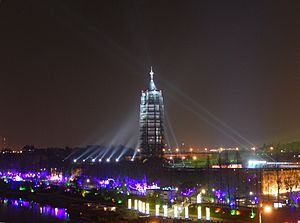Porcelain Tower of Nanjing facts for kids
Quick facts for kids Porcelain Tower of Nanjing |
|||||||||||||
|---|---|---|---|---|---|---|---|---|---|---|---|---|---|

Reconstructed Porcelain Tower
|
|||||||||||||
| Chinese | 琉璃塔 | ||||||||||||
| Literal meaning | "Veruliyam-Glazed Pagoda" | ||||||||||||
|
|||||||||||||
| Great Bao'en Temple | |||||||||||||
| Traditional Chinese | 大報恩寺 | ||||||||||||
| Simplified Chinese | 大报恩寺 | ||||||||||||
| Literal meaning | "Great Temple of Repaying Kindness" | ||||||||||||
|
|||||||||||||
The Porcelain Tower of Nanjing was an amazing and very tall building in Nanjing, China. It was part of a bigger place called the Great Bao'en Temple. This tower was built a long time ago, in the 1400s, during the Ming dynasty. Sadly, most of it was destroyed in the 1800s during a big conflict called the Taiping Rebellion. Today, you can see a new, full-size copy of the tower in Nanjing.
In 2010, a Chinese businessman named Wang Jianlin gave a lot of money – about 156 million US dollars – to Nanjing to rebuild the tower. This was the biggest personal donation ever in China! The new tower and a park around it opened in December 2015.
Contents
History of the Porcelain Tower
The Porcelain Tower of Nanjing was designed during the time of the Yongle Emperor, who ruled from 1402 to 1424. Its construction began in the early 1400s.
European travelers, like Johan Nieuhof, were among the first Westerners to see it. They sometimes even called it one of the Seven Wonders of the World. Because of this, the tower became known as a special national treasure in China and around the world.
On March 25, 1428, the Xuande Emperor ordered Zheng He and others to oversee the rebuilding of the Great Bao'en Temple in Nanjing. The temple's construction was finished in 1431.
Destruction of the Tower
In 1801, lightning struck the tower, and the top four stories were damaged. However, it was quickly repaired. A book from 1843, The Closing Events of the Campaign in China by Granville Gower Loch, gives a detailed description of the tower from that time.
In the 1850s, a civil war called the Taiping Rebellion reached Nanjing. The rebels took control of the city. They damaged the Buddhist statues inside the tower. They also destroyed the inner staircase to stop their enemies, the Qing army, from using it as a lookout.
American sailors visited the tower in May 1854, finding it empty inside. In 1856, the Taiping rebels completely destroyed the tower. They did this either to prevent their enemies from using it to watch and attack the city, or because they had superstitious fears about its geomantic properties. After the destruction, parts of the tower were used in other buildings. The site remained empty for many years until efforts began to rebuild this famous landmark.
What the Porcelain Tower Looked Like
The original tower had an eight-sided shape. Its base was about 30 metres (98 ft) (98 feet) wide. When it was first built, it was one of the tallest buildings in China. It stood about 79 metres (259 ft) (259 feet) high and had nine stories.
Inside, there was a spiral staircase with 184 steps that went all the way to the top. The very top of the roof had a golden pineapple shape. An American missionary who visited Nanjing in 1852 said there were plans to add even more stories to the tower.
Only a few other Chinese pagodas were taller than the Porcelain Tower. For example, the 84-metre-tall (276 ft) Liaodi Pagoda in Hebei, built in the 11th century, still stands today. There was also a 100-metre-tall (330 ft) wooden pagoda in Chang'an from the 7th century, but it no longer exists.
Materials and Decoration
The tower was built using special white porcelain bricks. People said these bricks would reflect the sun's rays during the day, making the tower shine. At night, as many as 140 lamps were hung from the building to light it up.
The porcelain bricks were decorated with colorful glazes and stoneware. These created beautiful designs in green, yellow, brown, and white on the sides of the tower. These designs included animals, flowers, and landscapes. The tower was also decorated with many images related to Buddhism.
Some small pieces of the original tower still exist today. You can find a few fragments in the Calcutta Museum in India. A very small piece is also kept at the Georgia Historical Society in Savannah, Georgia, USA.
Gallery
-
Artist impression of the Porcelain Tower before its destruction, based on the model displayed in the Nanjing Museum.
-
The Porcelain Pagoda, as illustrated in Fischer von Erlach's A Plan of Civil and Historical Architecture (1721)
Images for kids
-
The original blocks of the Nanjing Tower's arched door, now pieced back together and on display at the Nanjing Museum
-
The original blocks of the Nanjing Tower's arched door, now pieced back together and on display at the Nanjing Museum
-
The original blocks of the Nanjing Tower's arched door, now pieced back together and on display at the Nanjing Museum
-
The original blocks of the Nanjing Tower's arched door, now pieced back together and on display at the Nanjing Museum
See also
 In Spanish: Torre de porcelana para niños
In Spanish: Torre de porcelana para niños









